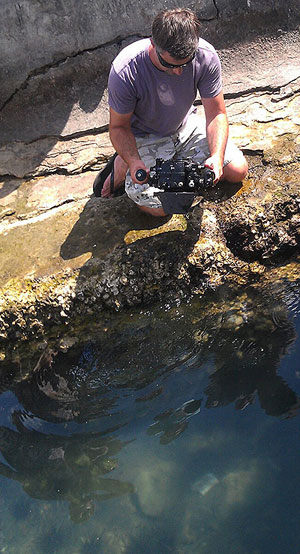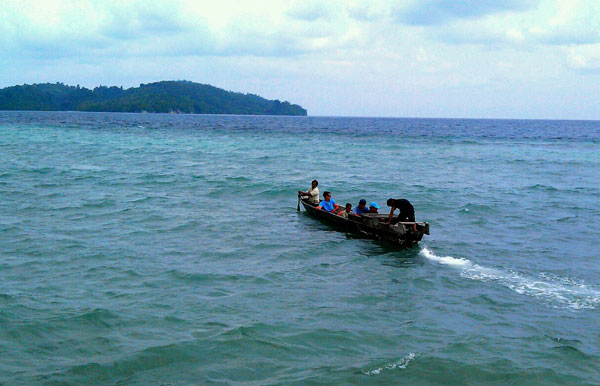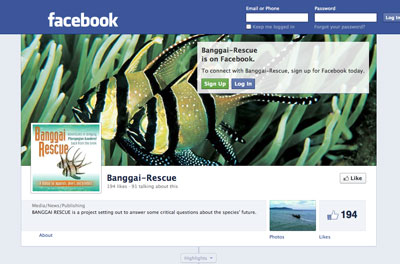Luwuk, Sulawesi, Indonesia
June, 2012
By Ret Talbot
As we’ve come to expect, it didn’t take long for U.S.-based scientists who are part of the Banggai Rescue (BR) international science team to find “invasive” Banggai Cardinalfish in Sulawesi. Upon arriving in Luwuk (Central Sulawesi) by increasingly smaller aircraft from Denpasar in Bali, the U.S.-based BR team members had most of a day to kill before meeting up with their Indonesian counterparts and heading by ferry to the Banggai Islands. What to do?
Look for Banggais, of course!

An introduced population of Banggai cardinalfish in Luwuk Harbour is oft-cited in the literature, and we suspected it would not be hard to find. So we arranged for a car and driver, loaded up the gear and headed out armed with pictures of the species on our phones and a rough approximation of local and trade names. We stopped at several places inquiring about the fish, and while the language barrier certainly exacerbated the situation, the fact that a couple of Americans wanted to see a small fish in the busy and polluted harbour proper as opposed to diving on a nearby near-pristine reef was our biggest obstacle. Finally, with a little more directive leadership, we turned away from the road headed out of town toward the pristine reefs and instead made our way down to Luwuk’s port proper.
The harbour, chiselled against a backdrop of dense mountain forest, was hot with a miasma of odors colliding beneath a blue sky fringed by cumulus clouds skirting the horizon. Wide wood-planked piers cut amidst a tapestry of brightly colored ferries and fishing boats, small traditional craft and a handful of government vessels. Flotsam sloshed in the shallows where freshwater runoff mixed with the stagnant backwater against the stone quay. Plastic bottles, foil wrappers and other sundry trash items were punctuated by the occasional fish carcas and a virtual smörgåsbord of discarded food waste.
Perhaps we wouldn’t get in the water here.
Right, Dr. Matt Wittenrich recording Banggai Cardinalfish near a jetty in Luwuk Harbour.
Our team, most of us glaringly white and no doubt a bit wide-eyed by the sudden assault on all senses, elicited curious stares from locals who clearly don’t see a lot of tourists poking around the Harbour with cameras. Undaunted, we approached the water’s edge with eager anticipation. From several meters away, the blackspine sea urchin clumps were easy to see. A little closer, and there was no doubt there were fish hovering about the urchin clumps. A little closer…and…definitely Banggai Cardinalfish…
…and lots of them!
While these were not the first Banggais we have seen in the wild in Indonesia (we’ve observed three other wild populations in Bali), seeing them here was still a thrill. After studying this animal for so long and from so many different perspectives, all of us could barely contain our enthusiasm. Pointing and talking in excited bursts, snapping photographs of what could only be described as severely degraded habitat, we must have provided Luwuk’s monthly quota of entertainment in a few short minutes.
Unknown Origins
What is often referred to as “a small population of unknown origins” in Luwuk Harbor, appeared to be alive and well, and depending upon how one defines small, it appears anything but. As we travelled around the harbor, we consistently saw Banggai Cardinalfish sheltering around urchins less than a meter from shore in shallow water. While there is some speculation in the literature that this could be

an endemic population, the latest research (both scientific and sociological) seems to point to an introduction by traders in Banggai Cardinalfish destined for the marine aquarium trade. (It is reported that fish handlers routinely cull damaged, deformed or dying fish and toss them overboard.)
Left, Banggai Rescue scientists Dr. Matt Wittenrich, Dr. Roy Yanong and Yunaldi Yahya head out with a local fisher (and an exceedingly capable young bailer) to collect samples from a village that reports collecting 18,000 Banggai Cardinalfish a month.
As previously reported, the Team has now observed two of the four or five sites where we have heard introduced populations of Banggais are thriving. In addition, the team observed Banggais in a location in North Bali we have not seen cited in the literature. These introduced populations–especially the now infamous Lembeh Straits population to the north–have, of course, been a significant talking point in the ongoing debate about the species and its conservation status.
With introduced populations doing so well even in areas with such abysmal water quality, could this truly be a species on the verge of collapse?
This is a line of reasoning put forth by some, including some members of the Indonesian Ministry of Marine Affairs and Fisheries Agency for Marine and Fisheries Research we have interviewed in Indonesia as part of our research.
Of course, as others have pointed out in the literature, this is a complex question. Without looking at extensive population data and understanding the significance and origins of introduced populations versus endemic populations (and without understanding the genetic diversity and the genetic flow (or lack thereof) of sub-populations of the species–a rush to judgement could be very damaging to the species’ future.

As has been frequently reported, this is a species believed to have an extremely limited endemic distribution. When one combines this with the fish’s high site fidelity and mouthbrooding characteristics (e.g., individuals don’t move very far from their parents throughout their entire life cycle), re-stocking (especially if the stock represent trader’s culled fish) or in-situ culturing initiatives could have deleterious impacts on the species overall genetic diversity. Throw the virus we are here to research into the equation, and fishery aside, it could easily be argued this a fish that needs a management plan to ensure its fitness into the future.
Filled with renewed excitement for the Banggai Rescue Project and our role in that Project, the U.S.-based team members headed back to the rendezvous point with our Indonesian counterparts. Tonight we are off to the Banggai Islands by ferry.